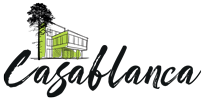
TIME TO RELAX!
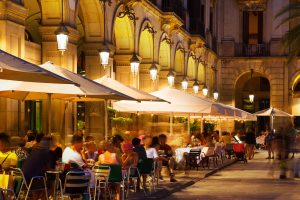
Restaurants
Not always obvious to find itself there. The jungle of bodegas, tascas, tabernas, tapas bars, marisquerías, mesones and restaurants, seems impenetrable, not to mention the schedules of the meals; which are 2 hours later than in France. Dare to plunge into the crowd in search of the bar and of the big hams, to choose a dish without understanding necessarily what you’ll have inside … That’s while testing that, you’ll become an expert!
Furthermore, most of the bars offer what to take a snatch at good price: tapilla or tapita (minitapas) often free with a consumption, and other dishes to order with your friends, in which you can peck as you want as pinchos (Basque appetizers), tostadas (sandwiches) and raciones (plates of tapas).
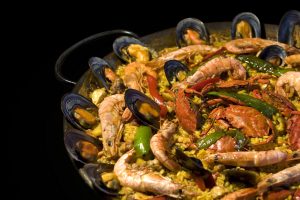
Culinary specialities
For those who do not love the unknown, we concocted you a lexicon of ‘los basicos españoles “:
– The paella: native of Valencia, this dish consists of a bottom of cooked rice in the oil at the same time as the chicken, the thin pork with ham, scampis, peas, garlic, onions, spices and saffron. Regarding its price the saffron is very often replaced by some turmeric or a food-colouring agent.
– The gazpacho: cold soup of Andalusian origin, compound of raw vegetables: tomatoes, peppers, onions, cucumbers, garlic, olive oil, vinegar and dry bread.
– Tortillas : cold or hot omelet, most of the time with potatoes, and herbs, tails of crawfishes, chorizo or tomatoes, bacon, peas, etc.
– The cocido: kind of beef stew with more or less of variants, served for main course and very roborant. Generally, served as day speciality, in certain restaurants, once a week.
Concerning sweetnesses, there are the churros, these sticks of crepe batter fried, inherited from the Arabic influence, the porras (big churros) and the buñuelos (doughnuts) to be dipped into the traditional very thick hot chocolate will know how to kink the greediest. Other delights, most of the time with milk and with eggs, the fawning frita, kind of béchamel sweet, thick and cooled then cut roughly squares fried in the oil then sprinkled with sugar, the tocino of cielo (cake in angel-hair pasta), natillas, custard thick and perfumed in the cinnamon or in the lemon, the arroz con leche (rice pudding), the torrijas…
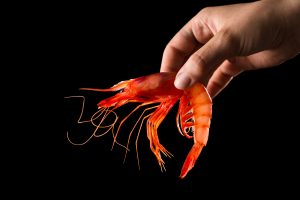
Gamba of Palamos
” The red gold ” of Palamós is the most popular product of Catalonia sea, and is one of the treasures of the Catalan gastronomy, which does its international fame.
Fished on the coast of Palamós, between the Cape of Begur and the riera of Ridaura (Platja d’ Aro), the gamba is considered as a flagship product within the Brotherhood of the fishermen of Palamós. The Gamba won its fame since 1950s, thanks to the technique of the dragnet fishing.
The newspaper Le Monde dedicated in its Culture section in June, 2014 a laudatory article on the Gamba de Palamós, where we have learned that she is very courted by numerous chefs as Gilles Goujon, Pierre Gagnaire, Sébastien Carmona-Porto, Alberto Herraiz. Transparent under the water, its colour on the surface becomes red with intense reflections. The Gamba differs from other sorts of shrimps by the big size of it head and from it antennas. With a delicate taste of hazelnut with an aroma sweeter than other shrimps, you have to consume it in 2 or 3 days following the fishing, before seeing it head darkening. The flesh is firm. It incomparable iodized aromas concentrate in it head that you can inhale or use in a stock (base of preparation of the diverse varieties of rice).
In high season, It price exceeds easily 100 €/kilo.
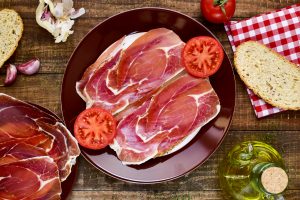
Tapas
In Spain, the tapas bar hopping is an art (of way of living) Spanish which we owe pay tribute …
But where does this tradition comes from ? In Spanish, the verb “tapar” means “covering, blocking”. So, the formers say that the origin of tapas is from a royal emanation. Indeed, to fight against the alcoholism, the king would have obliged barmans to put a plate with a snack on the glass of wine. The Moderns, them, argue that tapas would have been created in a utilitarian purpose: to prevent the flies from falling in the glass of wine. But as an empty saucer was not the most cheerful, they decided to add an olive, “to look nice”.
These appetizers, according to the inspiration of the boss, go from anchovies on toast to slices of chorizo, lamellas of ham in mixed salads, minipaellas to sardines, mushrooms to the garlic to boquerones (fresh anchovy) to the oil … You are probably going to cross some pinchos (or pintxos, a Basque word): it is one banged in a way, a big sofa on a slice of bread hold by a pike like a toothpick.
If you try to share a friendly moment, less formal than in a restaurant, cheap and fast: tapas are your best friends!
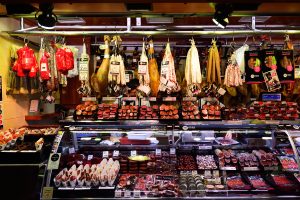
Open air market
Discover the products and the culture of Costa Brava through the numerous popular markets!
Traditionals and then became part of the tourist routes, markets are major releases to be made, in family, with friends … or alone.
Fish, meat, fruits and vegetables … The multiple and varied markets propose you a vast choice of food of quality and fresh healthy products, in the local custom. Do by yourself your tapas or your paellas thanks to these small jewels of tradition: the weekly markets feed the inhabitants of villages and establish centers of life, meeting places and big centers of attention, including for the visitors.

The fish auction
Besides the red Gamba of Palamós, flagship product which makes the pride of the country, the fishermen bring also to the port: cods, frying, sardines, burbots and numerous white fishes, lines, scampis, lobsters, crabs, octopuses, squids, sepia drawings, … The morning release of boats in the lively colours and massive trawlers is a real delight.
It is the noise of the engines that betrays the disciplined procession of tens of boats along the big dike in the direction of the wide, when the city still sleeps.
Even if this show is particularly early, you can however come to observe the return of the fishermen in the port, towards 16/17 hours, accompanied by troops of gulls and other gulls.
The fruit of the fishing already sorted out, is immediately landed and transported in the auction to be sold. The auction of the port of Palamós, main supply center of fishes in the region, is opened to the public from Monday to Friday, from 4 pm till 6 pm.
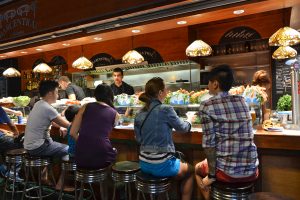
Bars
In Spain, to go bar-hopping became one real tradition. What better than to find itself around a cerveza (“beer” in Spanish) after a hard working day?
You will thus find three types of bars whom you can meet on your path :
– Cervecería: “brasserie” in the literal sense, thus beer bar
– Bodega: “wine cellar”, in practice a kind of wine bar
– Taberna: the traditional inn.
But all these names appoint the same thing: a bar where you can consume beers, wines and tapas.

Clubs
It is in Barcelona that the night is the most animated. Dozens of hyper-trendy places were born on the thrown of the years Movida. It is at a wild rhythm that opened the postmodern bars, the “neocold” pubs where pulses the electro music, and where the revellers meet them. To amuse you a maximum, we advise you three of our favourite spheres of influence:
– The zone B.C.B.G. (Pijo) over the Diagonal and along the Muntaner, where go especially the Inhabitants of Barcelona (customer around 30);
– The electro stage and the gays places;
– Finally, the Olympic sloppy Port for the youngers.
For the entry prices lists, often expensive, with a little of boldness and especially some tricks, you will pay only rarely the full price: there is a lot of invitations and discount flyers that you will find in numerous bars, stores of clothes, or even in the street, in the beach… Wherever, you can be insured that someone will give it to you.
Better, if you stay a few days, pre-register on the lists of entrance via Internet. Simpler, via Facebook, get into a group which will give you access to the often essential piston to be part of happy few of the inevitable evening of moment.
To well choose your club, the most effective is to check the look and the age of the people of the line. Be aware, depending on the nights, the atmosphere can change, then do not let you surprise!
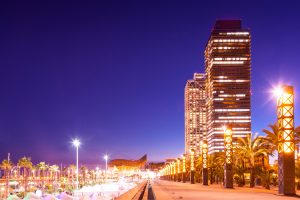
Nightlife in Barcelona
Barcelona works trough crushes, regarding the number of places ready to welcome you and the interests of each of you. In there, we do not sleep! The night-life from Barcelona (and from Spain generally) is certainly one of the most dynamic of the world.
At night, the street belongs to the night birds which teem in the most livened up districts. Barcelona, besides all the religious or commemorative feasts, has for peculiarity to be a very trendy city, one of the European temples of the electronic music (the fans of electro music will understand why the Sonar festival takes place in Barcelona); we don’t count anymore bars and clubs, and the city attracts every year thousands of young people, which come sweat in the rhythms of the hippest DJS, in atmospheres and frames as varied as their desires!
In brief, face to the very wide choice, do not hesitate to trust your intuition, according to your tastes and your festive desires.

Music live
If you wonder where to listen to music concerts on Costa Brava, the answer is… everywhere!
No problem to find, and this every evening, a bar or a nightclub where to listen to a concert. Furthermore, the traditions of parades, dances or walking orchestras are anchored in the Spanish life.
Once again, the biggest events and the festivals take place in Barcelona. The jazz lovers will consult classically the site of the international festival of jazz of Barcelona. Besides, the alleys of Barri Gòtic, around the cathedral, have a breathtaking acoustic, and it is not rare that when the sun is shining, the musicians come to make a set (till approximately 11 pm). Cellist, classic guitar, bandoneon … Music is close to you !
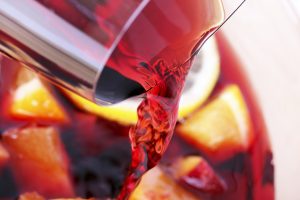
Hard drinks
Generally, alcohols the most consumed on Costa Brava and in all Spain are the beer (to vary the pleasures, order a « caña », a basic but very refreshing draft beer) and the wine (produced generally locally, around Madrid).
Trendier in these times, the « calimocho », very appreciated by the young people, is a drink which is neither more or less some red wine mixed with … Coca-Cola!
Easier to swallow and very common, the « calimocho », with wine and lemonade (gaseosa, but we often say « casera », which is the name of a brand). Consume it very freshly but always with moderation.
Finally, succumb to the originality of the « vermuth al grifo » : literally, vermouth from the faucet. It’s soaked fortified wine with herbs, delivered in small trays with some sparkling water. We pull it a little as some draft beer. It is light, refreshing, sparkling, and this has nothing to do with vermouths in bottle.

Soft drinks
And for the youngest or simply for those who do not drink alcohol, keep calm, Spanishes also know how to cool without alcohol.
The most refreshing drink, which we find a lot in summer, is the horchata, which everybody translates, wrongly, by “orgeat”. She is made with the juice of roots and stalks of the chufa, a kind of papyrus. A little more classic, the granizado of limón: lemon juice, sugar and crushed ice. We also find the version granizado of coffee or of varied fruits (orange, peach, etc.).
Other Spanish must since the discovery of Americas, the hot chocolate which does not look like ours. Here, it is a rich and nourishing drink, thickened in the starch, dense in aromas, and created especially to dip in the famous churros, these doughnuts stretched out of the breakfast
